Seattle is in the grip of a major cold wave along with most of the northern half of the US. Normally we are sheilded from that by the Japanese current and being at sea level more or less, but not this time. It has been below freezing for several days now.
Water flow through my icubator is stll moving, but not at the rate it was before the cold set in. I hope that I don't end up with any frozen pipes. I shouldn't as long as the water keeps moving. One thing this will do is slow down the maturation process of the eggs/alevin.
The timetable for salmon maturation from egg fertilization through release is fairly well documented and based on what are call "thermal units." One thermal unit is equal to 1 degree above 32 Farenheit for 24 hours. From fertilization to hatch is 750 thermal units; from hatch to release is 1,000 thermal units. I got my eggs early because of two factors; the fall run of coho salmon at Issaquah Creek hatchery was earlier than usual, and the water temperatures there were a bit higher than normal (causing the eggs to reach the 'eyed' stage earlier).
Water is not all that quick to respond to air temperature changes; it generally varies much more slowly than the air above it. I haven't ever measured the water temp in McAleer Creek, but have guessed it to be about 42 degrees (more or less). That gives me about 100-105 days from the time I get eggs in the incubator until I release them. The water going down a degree or even two would only slow that rate by a couple of days at most, so I'm guessing that fish release will still be some time around the end of March 2009.
I watch the outflow from the incubator a couple of times a day. As long as it is still flowing, my babies are going to be happy. So far, they are happy.
Thursday, December 18, 2008
Readin': Finish One trilogy, get close on another
Well, I got the second book of Lois McMaster Bujold's The Sharing Knife series, Legacy finished last week and it was as good as it could be. For a fantasy novel to be at all engaging, the characters have to be based in, and true to, their humanity. Legacy's characters return that in spades; both Dar and Fawn are well drawn and quite complex. The surrounding characters, also fairly well drawn, so a suprising mix of motives, emotions and actions, some of them ever-so-humanly pig-headed. The Beguilement ended with Dar and Fawn having married and headed toward the Lakewalker's encampment. Legacy ends with them on the road again, having found the Lakewalkers nowhere near as hospitable as they had hoped.
What lies in store for them? Don't know, but I am anxious to keep reading. Book Three is not yet out in paperback and I have a basic prejudice against buying books like this in anything but paperback. I can't find my King County Library card at the moment, but when I do, I will reserve the book. Presently the KCL system only has 1 copy and 31 requests for it, but I did notice that they have 15 or more copies on order; including one for our local library branch down at the mall.
Third Place Books came through with Worldwired, the third book in the Jenny Casey trilogy. It was a great read and well worth the time. Jenny is a hugely complex, sympathetically drawn character with a long, military history and a senior non-com's inherent fatalism/cyncism and highly accurate bullshit detector. Lots of surprises, including a major league gunfight in the United Nations General Assembly. It does end suprisingly well. Well worth readying
What lies in store for them? Don't know, but I am anxious to keep reading. Book Three is not yet out in paperback and I have a basic prejudice against buying books like this in anything but paperback. I can't find my King County Library card at the moment, but when I do, I will reserve the book. Presently the KCL system only has 1 copy and 31 requests for it, but I did notice that they have 15 or more copies on order; including one for our local library branch down at the mall.
Third Place Books came through with Worldwired, the third book in the Jenny Casey trilogy. It was a great read and well worth the time. Jenny is a hugely complex, sympathetically drawn character with a long, military history and a senior non-com's inherent fatalism/cyncism and highly accurate bullshit detector. Lots of surprises, including a major league gunfight in the United Nations General Assembly. It does end suprisingly well. Well worth readying
Thursday, December 11, 2008
Raisin' Fish: Loading the Barrel
By 7:30 this morning, Gwynedd and I were on the road, arriving at Issaquah Salmon Hatchery around 8:15. We headed for the office to sign paperwork first (salmon eggs, especially fertilized ones, are a valuable resource, so you have to carry documentation that you got the eggs in a legitimate fashion).

Once all the signatures were in place we headed out to the room were I have been picking up my eggs for the past 10 years.
There they were, just waiting for us.

The eggs were transferred into a scale so they can be weighed. Earlier the hatchery folks had weighed a sample and knew how many eggs were in a pound (1536, today), so they could figure out how many pounds of eggs to give us. Here the eggs go from the baskets to the scale.
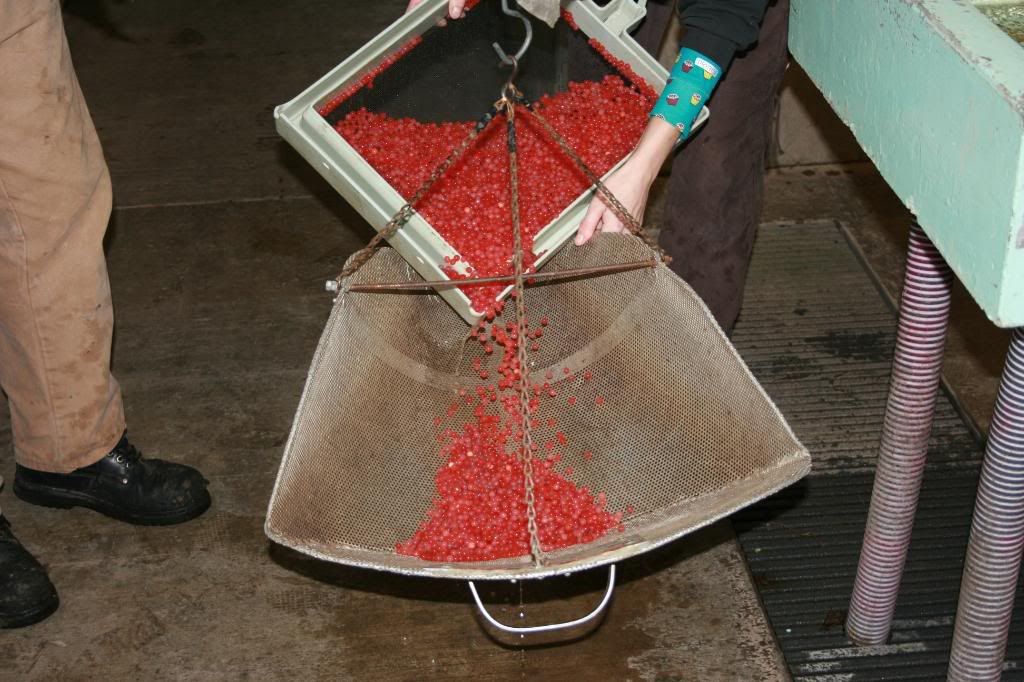
The eggs were poured into the cheescloth bags I had brought with me.

The first year I went to get eggs, I was a rank amateur. I asked the hatchery tech how big a bucket I should bring to carry the eggs home.
To my surprise, he said, "None."
When I asked why, he asked me, "If I taped a bucket over your head and sealed it all up, do you think you could drive all the way home before you ran out of air?"
I said "No."
To which he replied, "Well neither can the fish. They will exhaust all of the oxygen in the water and then suffocate. If you bring breathable cloth bags and keep the eggs moist and out of any drafts, they'll transpire oxygen right out of the air through their egg casings."
As each bag was filled, I took it out to my pickup truck and placed it on the wet towel laid in the back. They were then covered with another towel for the ride home. Here they are resting happily for their ride to Lake Forest Park.
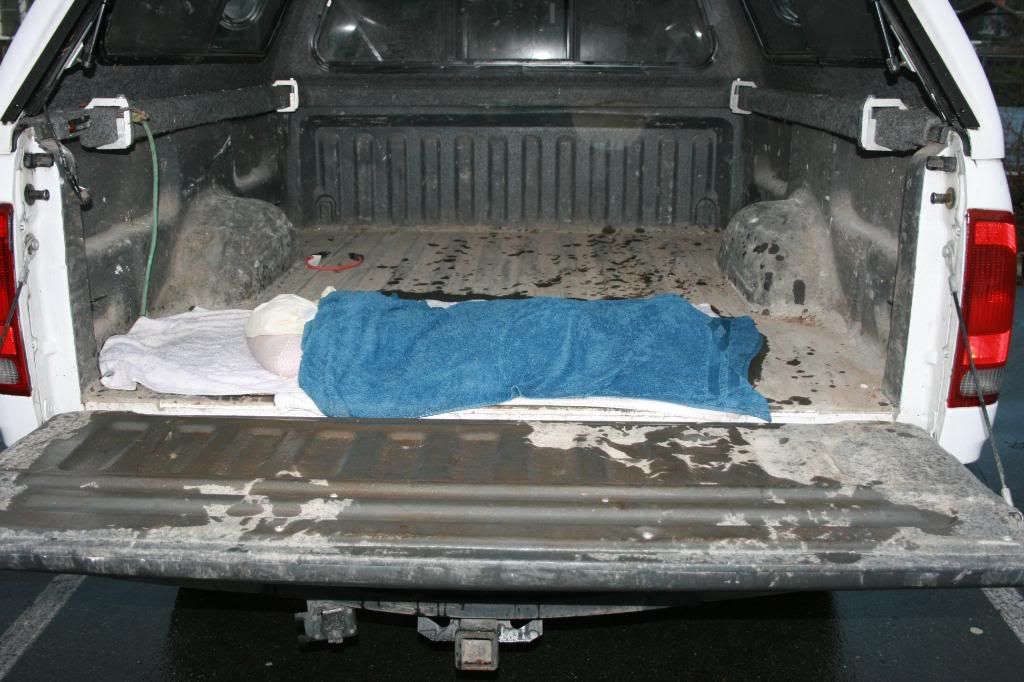
The water was flowing strongly through the incubator this morning, as it had been for the past several days. When I pass by, all I have to do is look at the angle of the water and the amount coming out to judge whether or not we are getting sufficient flow for the fish. The flow you see there is about 11 gallons/minute.
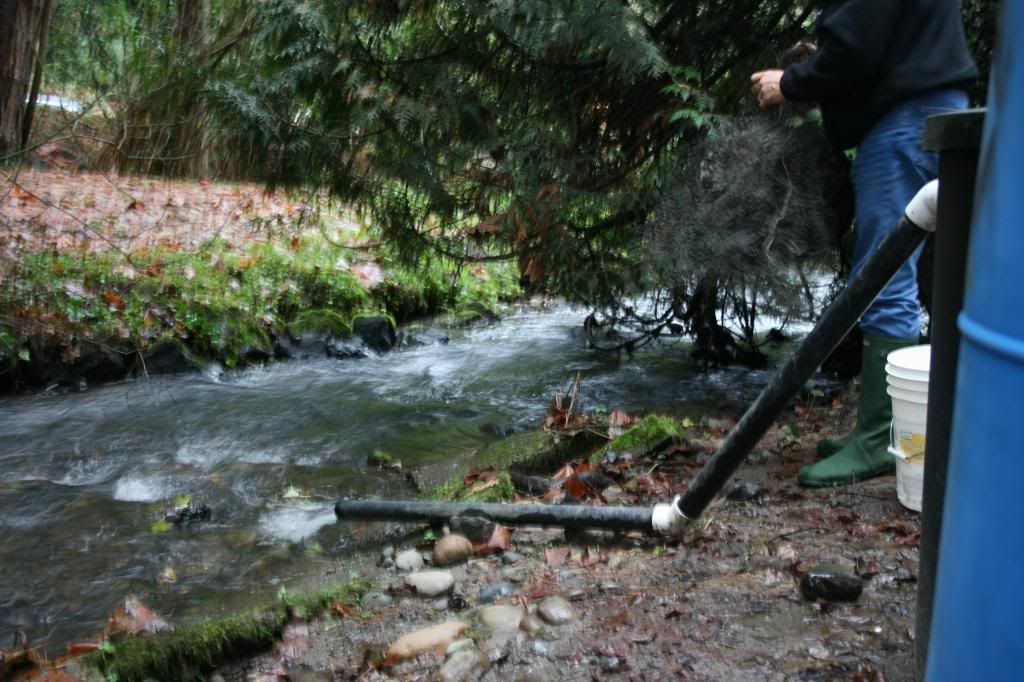
Before placing the eggs into the incubator there was an additional step; soaking the eggs in an iodine/creek water solution for 5 minutes. This soaking decreases the possibility of carrying any micro-organisms from the Issaquah Creek watershed into McAleer Creek's watershed. Here's the first bag of eggs in the solution.
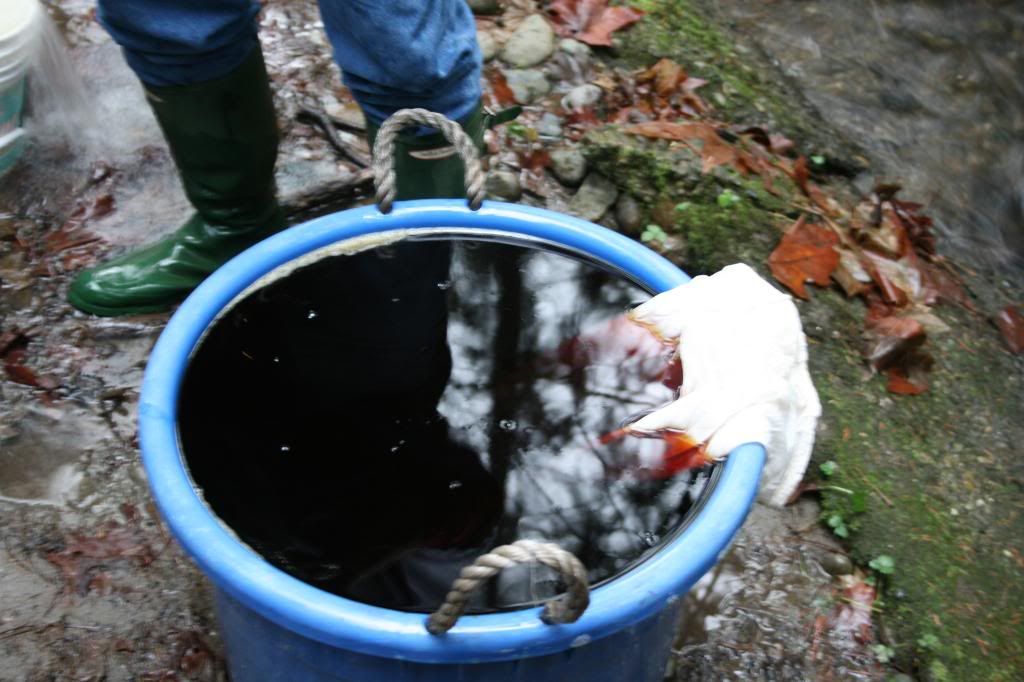
While we were waiting for the eggs, we put the bag of plastic media and the first tray into the incubator.
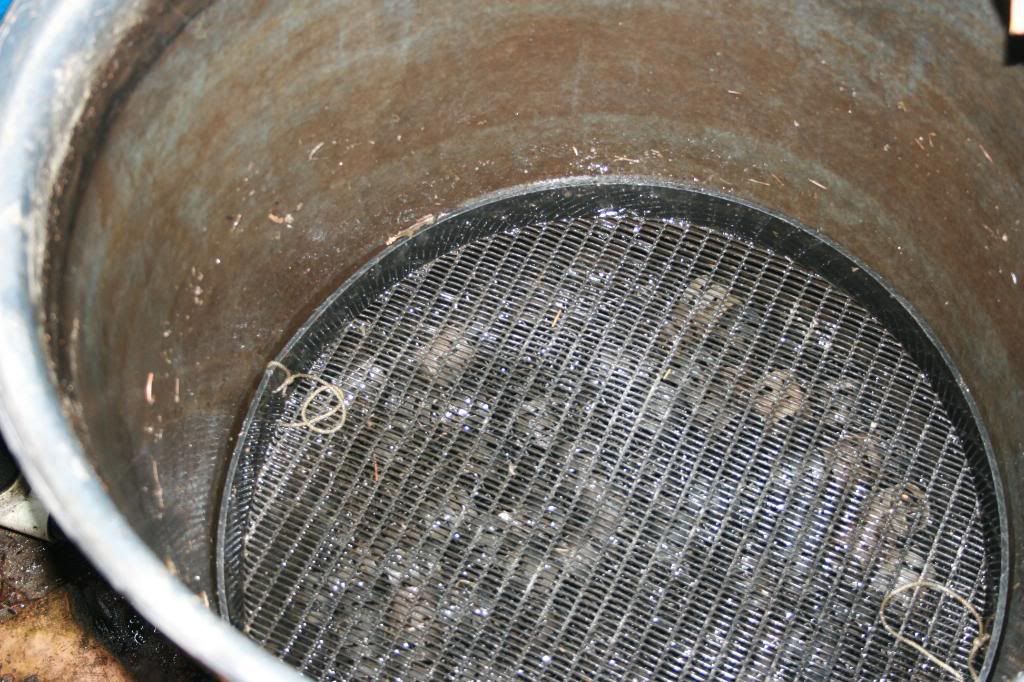
Now comes one of the coolest parts of the process, pouring the eggs into the trays. The eggs are about the size of small peas and have a smooth, almost liquid consistency to them. They pour into the tray like a bright and spreading pink hill.
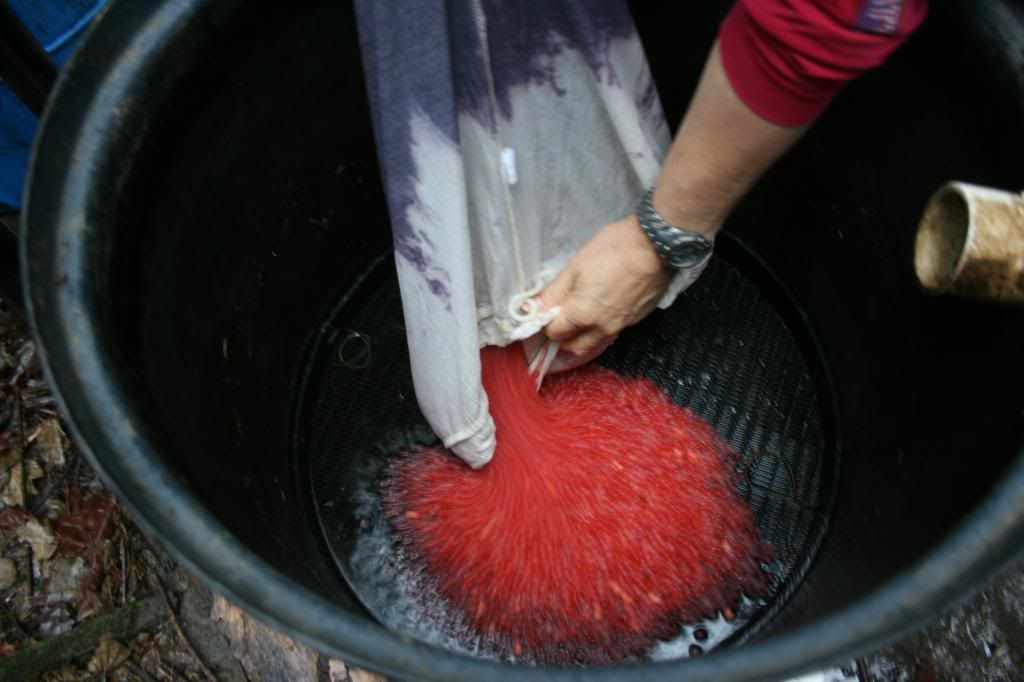
It's important to turn the bags inside out very carefully over the incubator, as some eggs invariably stick to the side of the bags. Any one of these little marvels could grow up to feed a seal, an orca, or even one of my blog readers (few as they are). Wouldn't want to miss any!
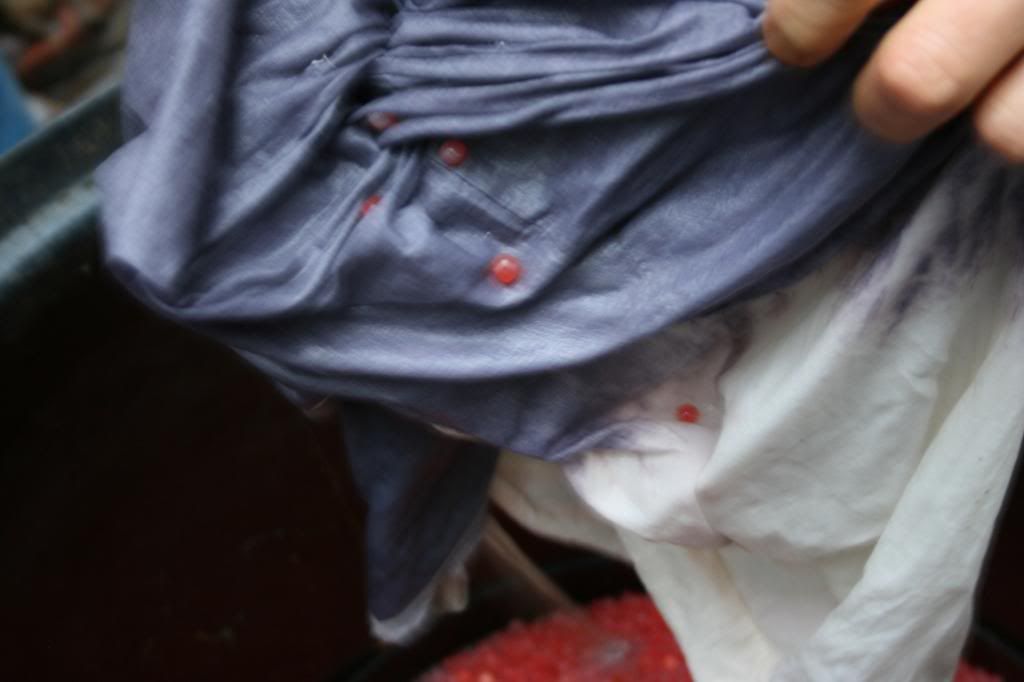
Now comes the tedious part. You have probably noticed in the pictures that some of the eggs are much lighter in color than the others. Those light, almost white, eggs are dead. Sadly, they don't all make it. An important part of the process, though is to remove the dead ones early on, so that they don't rot and kill any of their brethren (or sistren). You run your hands through the eggs to stir them up a bit and then take the dead ones out one at a time. Time consuming? Yes. Tedious? yes, again. But absolutely necessary to the health of the surviving eggs in the incubator.
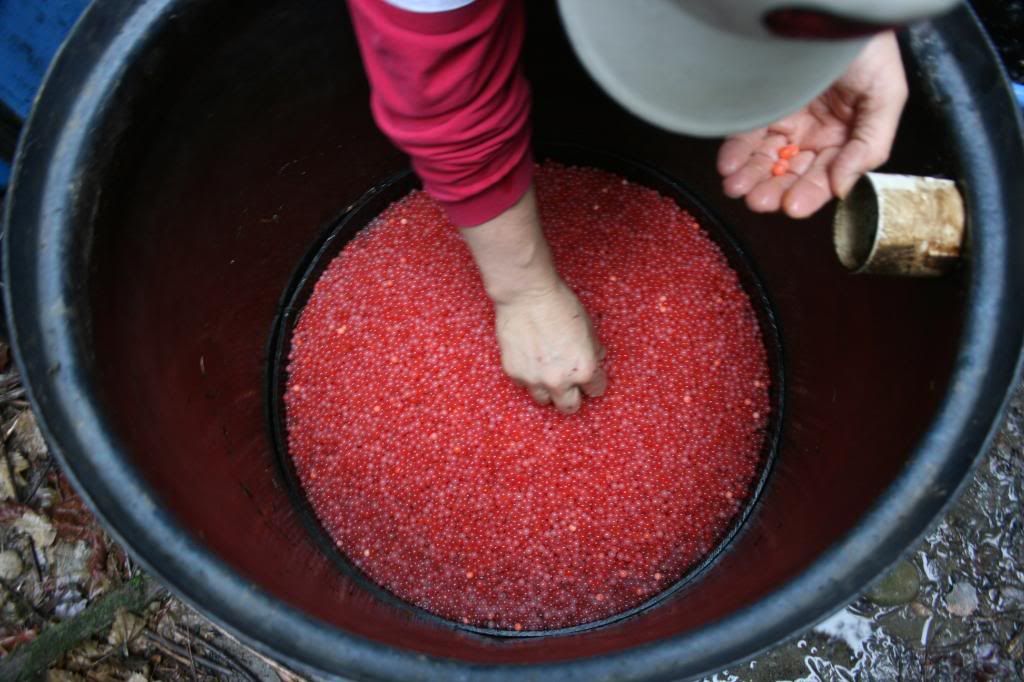
Here's what healthy coho salmon eggs at the 'eyed' stage look like. Those two black dots will become the fish's eyes and that white line between the eyes will become the spinal cord of the fish (among other things). Amazing that something so small can eventually grow to be 8-15 lbs and 20-30 inches long.

Here's what a dead egg looks like; all white and opaque instead of translucent and vibrantly colored like the live ones. They even feel different; the live ones are resilient and kind of bouncy, the dead ones are hard and stiff.
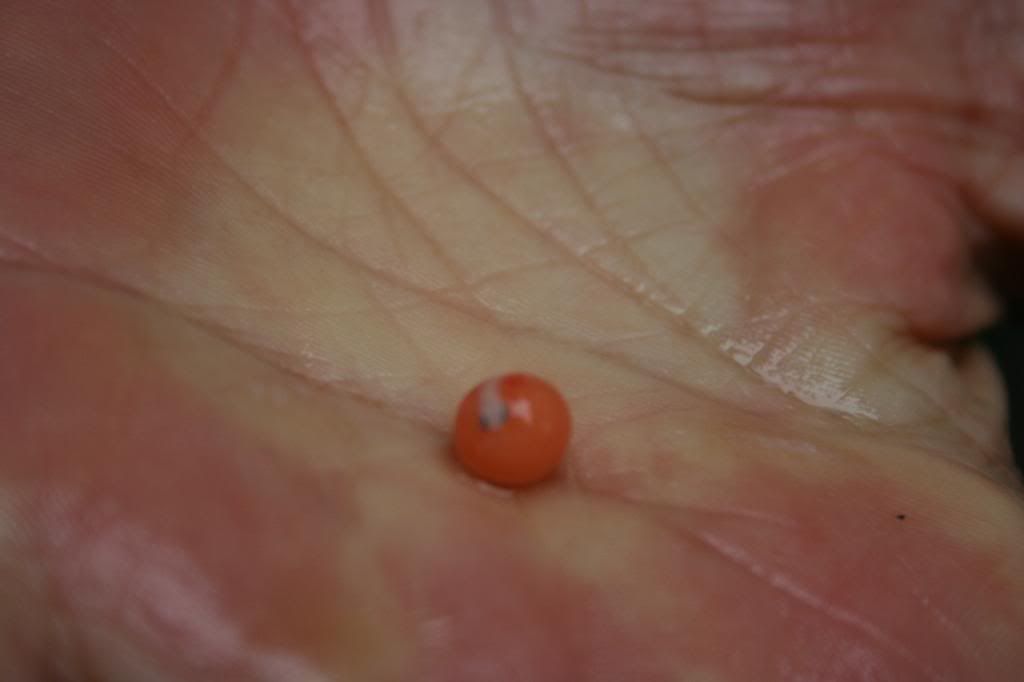
As we picked the dead eggs out, we threw them into the creek. A bunch of them began to accumulate behind one of the rocks in the creek. The smell of the eggs was surely being wafted downstream. I was hoping that some scavenger like a crawdad, or maybe a trout, would come looking for this easy breakfast. If they did come, it was after we were already gone.
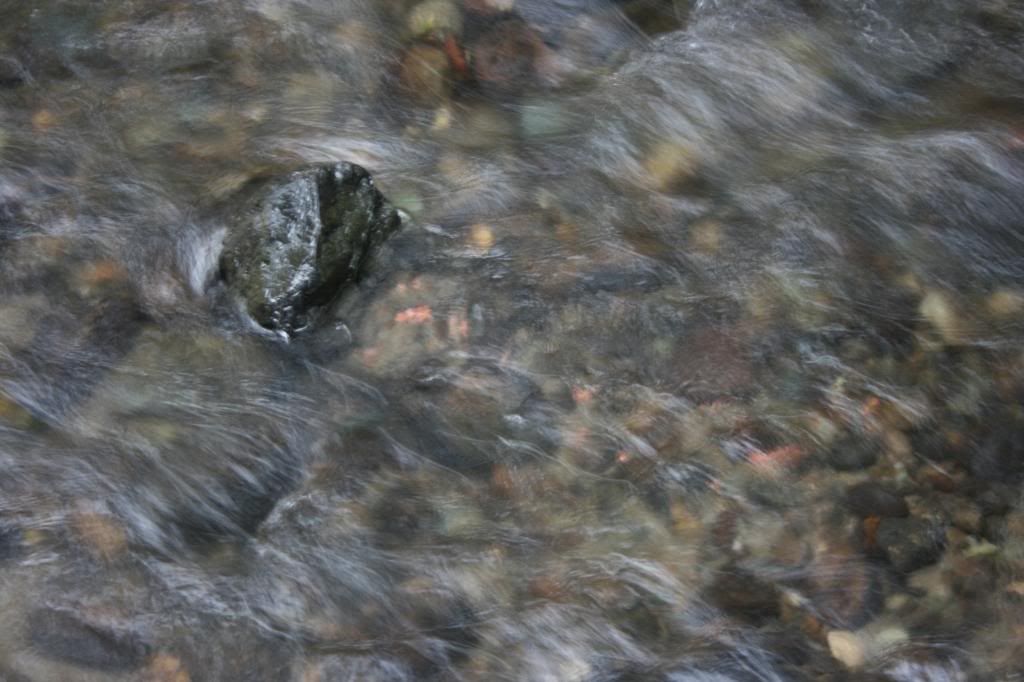
We repeated the process twice more; putting down a new empty tray, soaking the eggs in iodine, pouring them in and picking out the dead ones. By 10:30 in the morning, Gwynedd and I had put approximately 70,000 coho salmon eggs into their new home beside McAleer Creek.
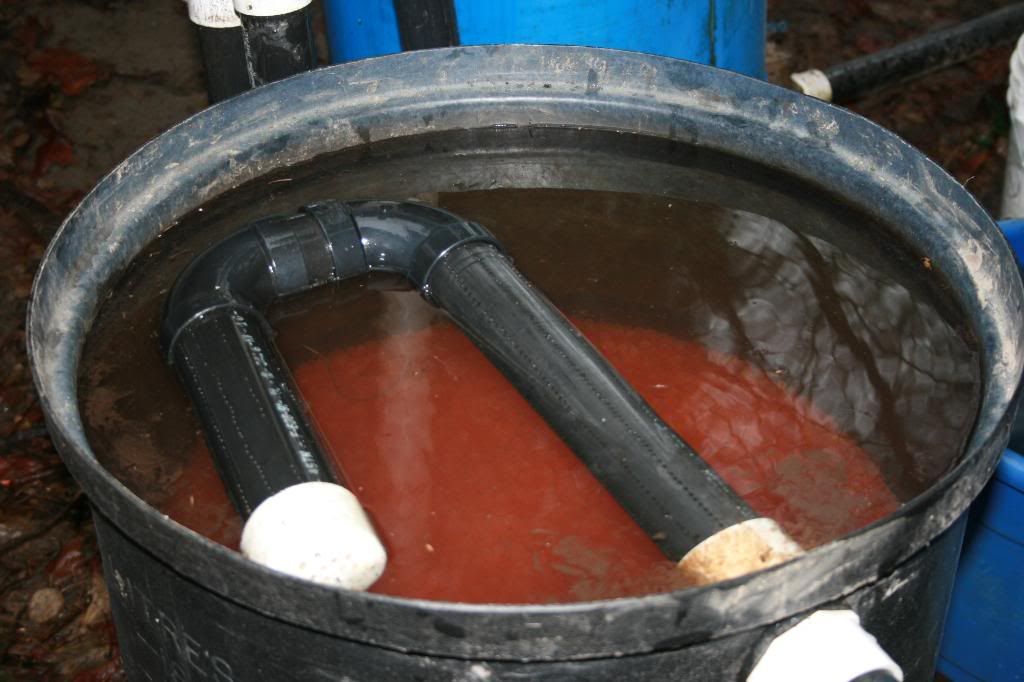
Thanks to Gwynedd for taking the pictures. She took many more than this; these were the prettiest ones that told the story.

Once all the signatures were in place we headed out to the room were I have been picking up my eggs for the past 10 years.
There they were, just waiting for us.

The eggs were transferred into a scale so they can be weighed. Earlier the hatchery folks had weighed a sample and knew how many eggs were in a pound (1536, today), so they could figure out how many pounds of eggs to give us. Here the eggs go from the baskets to the scale.

The eggs were poured into the cheescloth bags I had brought with me.

The first year I went to get eggs, I was a rank amateur. I asked the hatchery tech how big a bucket I should bring to carry the eggs home.
To my surprise, he said, "None."
When I asked why, he asked me, "If I taped a bucket over your head and sealed it all up, do you think you could drive all the way home before you ran out of air?"
I said "No."
To which he replied, "Well neither can the fish. They will exhaust all of the oxygen in the water and then suffocate. If you bring breathable cloth bags and keep the eggs moist and out of any drafts, they'll transpire oxygen right out of the air through their egg casings."
As each bag was filled, I took it out to my pickup truck and placed it on the wet towel laid in the back. They were then covered with another towel for the ride home. Here they are resting happily for their ride to Lake Forest Park.

The water was flowing strongly through the incubator this morning, as it had been for the past several days. When I pass by, all I have to do is look at the angle of the water and the amount coming out to judge whether or not we are getting sufficient flow for the fish. The flow you see there is about 11 gallons/minute.

Before placing the eggs into the incubator there was an additional step; soaking the eggs in an iodine/creek water solution for 5 minutes. This soaking decreases the possibility of carrying any micro-organisms from the Issaquah Creek watershed into McAleer Creek's watershed. Here's the first bag of eggs in the solution.

While we were waiting for the eggs, we put the bag of plastic media and the first tray into the incubator.

Now comes one of the coolest parts of the process, pouring the eggs into the trays. The eggs are about the size of small peas and have a smooth, almost liquid consistency to them. They pour into the tray like a bright and spreading pink hill.

It's important to turn the bags inside out very carefully over the incubator, as some eggs invariably stick to the side of the bags. Any one of these little marvels could grow up to feed a seal, an orca, or even one of my blog readers (few as they are). Wouldn't want to miss any!

Now comes the tedious part. You have probably noticed in the pictures that some of the eggs are much lighter in color than the others. Those light, almost white, eggs are dead. Sadly, they don't all make it. An important part of the process, though is to remove the dead ones early on, so that they don't rot and kill any of their brethren (or sistren). You run your hands through the eggs to stir them up a bit and then take the dead ones out one at a time. Time consuming? Yes. Tedious? yes, again. But absolutely necessary to the health of the surviving eggs in the incubator.

Here's what healthy coho salmon eggs at the 'eyed' stage look like. Those two black dots will become the fish's eyes and that white line between the eyes will become the spinal cord of the fish (among other things). Amazing that something so small can eventually grow to be 8-15 lbs and 20-30 inches long.

Here's what a dead egg looks like; all white and opaque instead of translucent and vibrantly colored like the live ones. They even feel different; the live ones are resilient and kind of bouncy, the dead ones are hard and stiff.

As we picked the dead eggs out, we threw them into the creek. A bunch of them began to accumulate behind one of the rocks in the creek. The smell of the eggs was surely being wafted downstream. I was hoping that some scavenger like a crawdad, or maybe a trout, would come looking for this easy breakfast. If they did come, it was after we were already gone.

We repeated the process twice more; putting down a new empty tray, soaking the eggs in iodine, pouring them in and picking out the dead ones. By 10:30 in the morning, Gwynedd and I had put approximately 70,000 coho salmon eggs into their new home beside McAleer Creek.

Thanks to Gwynedd for taking the pictures. She took many more than this; these were the prettiest ones that told the story.
Wednesday, December 10, 2008
Raisin' Fish: Running Water
So, Saturday was a busy day on McAleer Creek. Because I am getting fish tomorrow, I had to get the whole incubator system clean and functioning in one day. This was not as hard as you might think. I have been doing this for 10 years now (this in #11) and I have had a certain amount of practice on all of these activities before.
So, first things first. Here is what the incubator looked like early Saturday morning.
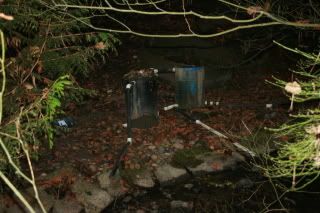
The incubator is on the left; the clarifier is on the right. The piping on the right leads 500' up the creek to the inlet tube. Water flows in at the bottom of the clarifier and then out at the top. It goes into the bottom of the incubator and then out again at the top. Notice that there is no water flowing out of the outlet tube on the incubator. Both the incubator and clarifier have the crud of one season out in the weather goobering up their outsides. The insides are a bit murkier than that.
This is what the inside of the clarifier looked like before I began cleaning anything up. It is a mix of sand, silt and leaves (I had left the top off the clarifier and it is surrounded by trees.
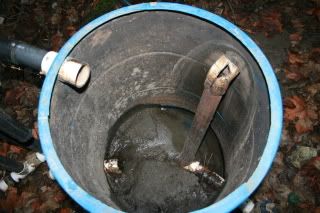
First things first. Getting water flowing through the system will make everything else easier. As I said earlier, the inlet pipe is about 500' up creek from the incubator. It is a 6" diameter pipe with a bunch of holes drilled in it. During the course of the previous year, McAleer Creek had changed its flow pattern a bit, so the inlet pipe wasn't getting any water. The first thing I had to do was fix that. This is what the inlet pipe looked like before I began work.
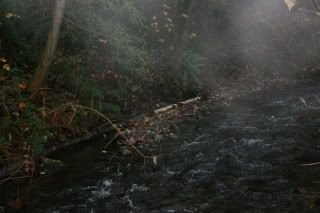
I modified the creek bed as little as possible (there are all kinds of insects and other critters that live in the gravel/sand/rocks and I wanted to make as small a disturbance as possible), but still managed to get enough water flowing to cover most of the inlet tube. That took almost two hours.
After lunch, I came back out to the incubator and water was flowing through the clarifier. I cleaned that out and then started on the incubator itself. There wasn't much in there; just the stuff at the very bottom, which I'll show you pictures of all cleaned up. The incubator is a 50 gallon plastic drum (the only metal you can use is stainless steel, everything else gives off ions that will be bad for the fish, so we use stainless steel screws to hold the piping together). The water flows in at the bottom into a cross-shaped piece of piping that has holes drilled in the bottom (so that the force of the water is disapated against the bottom of the barrel and rises gently through the other layers). It looks like this:
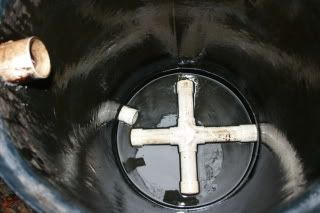
Don't get too confused by it; it's kinda clean and shiny inside, so there's that wierd curvy reflection on the right hand wall. There's also a clean-out pipe at the bottom and the outlet pipe at the top, both on the left hand side of the barrel.
Next I put down the stainless steel screen that supports everything else.
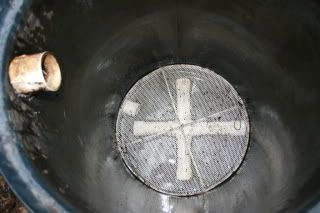
It is supported by a ring of white plastic and some cross bracing across the diameter.
Next comes a layer of pea gravel about 1" thick.

Before I got started cleaning the incubator, that pea gravel was covered with a layer of silt about 1" thick; a dense mass of yuck that had to be cleaned out mostly by hand. At the end, though, I poured gallons and gallons of water in there and let everything flow out the clean out pipe at the bottom.
On top of the pea gravel I will put a bag of plastic media that look like barrels with a bunch of slots cut out of them. This is one of them:
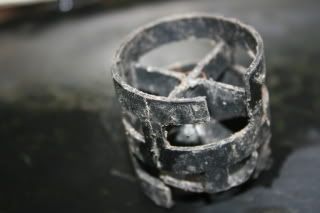
The whole bag of them looks like this:

As you can see, they don't stack together very well. Once the eggs hatch out, the alevin (what a just-hatched salmon is called) will swim down through the trays and hide out in the media for a couple of months. All of those nooks and crannies are good places for hiding. In the wild they would do this by burrowing into the spaces in the gravel around their nest.
Tomorrow, when I get the eggs, you won't see any of that stuff (and I won't see if for another 3-4 months once the eggs are loaded into the incubator), but you will see the trays that go on top of the bag of little barrels. Here are all five of them stacked in my garage.
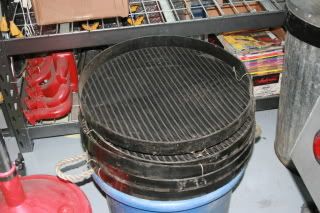
Once I got the water flowing through the incubator, it was time to optimize its flow. To support 70,000 eggs/alevin/fry (actually the barrel can hold 125,000 if you can believe that), you need about 10 gallons of cold, well-oxegynated water flowing through the system. The eggs will breathe that oxygen directly from the water; the alevin/fry will breathe it as well once they appear. At the beginning of optimization we were getting about 5 gallons/minute (maybe, I didn't bother to measure it, just estimated it by eye, having seen water flow out of the incubator for the last decade). This is what it looked like (notice how much cleaner and well ordered everything is than in the first picture - I was working hard):
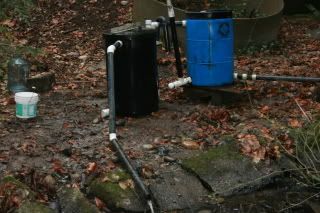
Optimizing means flushing all the gunk out of the lines and then bleeding the air out of the pipes at the high spots. If the pipe fell in a perfectly straight line from the inlet to the clarifier, the bleeding would be unneccessary. But the pipe rises and dips, doing its best to follow the level of the stream, but not completely succeeding. Hence the need to fiddle with it.
Here's a picture of my son, Francis, flushing out one of the pipes.
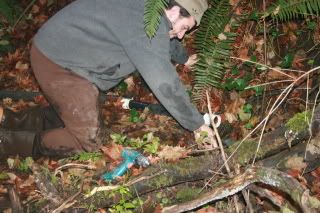
Notice the cordless drill by his knee? That's what we use to bleed the system. As I said earlier the pipes are held together with stainless steel screws at the junctions of each 10' section. You just unscrew one or both screws and let any air trapped in that section of pipe escape. It's really pretty simple.
While we were walking through the creek we saw a really cool sign. This is it:
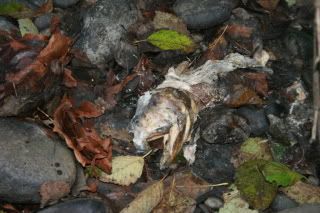
Yes, that is a dead salmon head lying in the gravel on the side of McAleer Creek. This is a very good thing for at least two reasons. One, it means we are getting returning fish. Two, once the fish die they begin rotting in place. Their bodies provide fertilizer for the plant life along the stream which feeds the insects that will become the food for their little babies. Circle of life, Indeed.
By the time we were through flushing the pipes it was 3:30. I had to leave to get ready for dinner and a UW men's basketball game (vs Texas Southern, which they won 88 - 52, bringing our record to 6-3), so Francis finished bleeding the system in the dark (sunset is early in December in the Pacific Northwest, it's full dark by 4:30 these days). When I checked the incubator the next morning, we were getting flow of a little better than 10 gallons/minute. We are ready.
Tomorrow is the big day. My daughter, Gwynedd, is accompanying me and will be taking pictures, so I'll give you the complete pictorial rundown of loading fish into the barrel either tomorrow or Thursday night. We leave for Issaquah Hatchery around 7:30 tomorrow morning. I know it seems silly, but I am tremendously excited. I really like doing this project; it gives me a sense of participation in the natural world that is significantly more intense than just watching it all from my windows.
So, first things first. Here is what the incubator looked like early Saturday morning.

The incubator is on the left; the clarifier is on the right. The piping on the right leads 500' up the creek to the inlet tube. Water flows in at the bottom of the clarifier and then out at the top. It goes into the bottom of the incubator and then out again at the top. Notice that there is no water flowing out of the outlet tube on the incubator. Both the incubator and clarifier have the crud of one season out in the weather goobering up their outsides. The insides are a bit murkier than that.
This is what the inside of the clarifier looked like before I began cleaning anything up. It is a mix of sand, silt and leaves (I had left the top off the clarifier and it is surrounded by trees.

First things first. Getting water flowing through the system will make everything else easier. As I said earlier, the inlet pipe is about 500' up creek from the incubator. It is a 6" diameter pipe with a bunch of holes drilled in it. During the course of the previous year, McAleer Creek had changed its flow pattern a bit, so the inlet pipe wasn't getting any water. The first thing I had to do was fix that. This is what the inlet pipe looked like before I began work.

I modified the creek bed as little as possible (there are all kinds of insects and other critters that live in the gravel/sand/rocks and I wanted to make as small a disturbance as possible), but still managed to get enough water flowing to cover most of the inlet tube. That took almost two hours.
After lunch, I came back out to the incubator and water was flowing through the clarifier. I cleaned that out and then started on the incubator itself. There wasn't much in there; just the stuff at the very bottom, which I'll show you pictures of all cleaned up. The incubator is a 50 gallon plastic drum (the only metal you can use is stainless steel, everything else gives off ions that will be bad for the fish, so we use stainless steel screws to hold the piping together). The water flows in at the bottom into a cross-shaped piece of piping that has holes drilled in the bottom (so that the force of the water is disapated against the bottom of the barrel and rises gently through the other layers). It looks like this:

Don't get too confused by it; it's kinda clean and shiny inside, so there's that wierd curvy reflection on the right hand wall. There's also a clean-out pipe at the bottom and the outlet pipe at the top, both on the left hand side of the barrel.
Next I put down the stainless steel screen that supports everything else.

It is supported by a ring of white plastic and some cross bracing across the diameter.
Next comes a layer of pea gravel about 1" thick.

Before I got started cleaning the incubator, that pea gravel was covered with a layer of silt about 1" thick; a dense mass of yuck that had to be cleaned out mostly by hand. At the end, though, I poured gallons and gallons of water in there and let everything flow out the clean out pipe at the bottom.
On top of the pea gravel I will put a bag of plastic media that look like barrels with a bunch of slots cut out of them. This is one of them:

The whole bag of them looks like this:

As you can see, they don't stack together very well. Once the eggs hatch out, the alevin (what a just-hatched salmon is called) will swim down through the trays and hide out in the media for a couple of months. All of those nooks and crannies are good places for hiding. In the wild they would do this by burrowing into the spaces in the gravel around their nest.
Tomorrow, when I get the eggs, you won't see any of that stuff (and I won't see if for another 3-4 months once the eggs are loaded into the incubator), but you will see the trays that go on top of the bag of little barrels. Here are all five of them stacked in my garage.

Once I got the water flowing through the incubator, it was time to optimize its flow. To support 70,000 eggs/alevin/fry (actually the barrel can hold 125,000 if you can believe that), you need about 10 gallons of cold, well-oxegynated water flowing through the system. The eggs will breathe that oxygen directly from the water; the alevin/fry will breathe it as well once they appear. At the beginning of optimization we were getting about 5 gallons/minute (maybe, I didn't bother to measure it, just estimated it by eye, having seen water flow out of the incubator for the last decade). This is what it looked like (notice how much cleaner and well ordered everything is than in the first picture - I was working hard):

Optimizing means flushing all the gunk out of the lines and then bleeding the air out of the pipes at the high spots. If the pipe fell in a perfectly straight line from the inlet to the clarifier, the bleeding would be unneccessary. But the pipe rises and dips, doing its best to follow the level of the stream, but not completely succeeding. Hence the need to fiddle with it.
Here's a picture of my son, Francis, flushing out one of the pipes.

Notice the cordless drill by his knee? That's what we use to bleed the system. As I said earlier the pipes are held together with stainless steel screws at the junctions of each 10' section. You just unscrew one or both screws and let any air trapped in that section of pipe escape. It's really pretty simple.
While we were walking through the creek we saw a really cool sign. This is it:

Yes, that is a dead salmon head lying in the gravel on the side of McAleer Creek. This is a very good thing for at least two reasons. One, it means we are getting returning fish. Two, once the fish die they begin rotting in place. Their bodies provide fertilizer for the plant life along the stream which feeds the insects that will become the food for their little babies. Circle of life, Indeed.
By the time we were through flushing the pipes it was 3:30. I had to leave to get ready for dinner and a UW men's basketball game (vs Texas Southern, which they won 88 - 52, bringing our record to 6-3), so Francis finished bleeding the system in the dark (sunset is early in December in the Pacific Northwest, it's full dark by 4:30 these days). When I checked the incubator the next morning, we were getting flow of a little better than 10 gallons/minute. We are ready.
Tomorrow is the big day. My daughter, Gwynedd, is accompanying me and will be taking pictures, so I'll give you the complete pictorial rundown of loading fish into the barrel either tomorrow or Thursday night. We leave for Issaquah Hatchery around 7:30 tomorrow morning. I know it seems silly, but I am tremendously excited. I really like doing this project; it gives me a sense of participation in the natural world that is significantly more intense than just watching it all from my windows.
Friday, December 5, 2008
The First Law: Book Two - Before They Are Hanged . . . and a few corrections
Before They Are Hanged is a great book in the second-book-in-a-trilogy genre. It takes all of the major characters' stories and moves them along in interesting ways, provides many of its own suprises both in character development and plot twists, and leaves you wanting that third book right now. Laura will finish it soon enough and then I'll get back to that.
In the meantime, I have some corrections to make. The Lois McMaster Bujold books are another trilogy, not a two-volume set as I originally thought. In addition, the title of the series is The Sharing Knife and the title of the first volume is Beguilement. Now that I have cleared up my own confusion, I can tell you a bit about the books. The two main characters, Dag Redwing Hickory, a Lakewalker on patrol, and Fawn Bluefield, a farmer girl running away from her family and an unintended pregnancy, meet on the road in perilous circumstances. Fawn saves Dag; Dag saves Fawn; Dag nurses Fawn back to health. Dag takes Fawn back to her family but not before falling in love with her. Once at her family's farm, it becomes clear to him that they will marry and they do. Beguilement ends with them leaving the farm after the wedding and heading for the Lakewalker encampment and an uncertain welcome and future.
Legacy, the second book in the trilogy, opens where Beguilement leaves off. I'm about a third of the way into it at the moment. The couple have arrived at the Lakewalker encampment and conflict ensues. Lakewalkers are forbidden to marry farmers and Dag has done just that. There will be a reckoning, but it has not yet happened. Bujold is a great writer; her characters are fully drawn and both their actions and there inner lives are portrayed with empathy and telling detail. The story is eminently readable. Good stuff.
When I went to Third Place Books the other night, they didn't have a copy of Worldwired, so I ordered it. I hope it will be in by the time I finish Legacy. In any case, I doubt that I'll be doing all that much reading this weekend as I need to get the incubator on line before Wednesday morning.
In the meantime, I have some corrections to make. The Lois McMaster Bujold books are another trilogy, not a two-volume set as I originally thought. In addition, the title of the series is The Sharing Knife and the title of the first volume is Beguilement. Now that I have cleared up my own confusion, I can tell you a bit about the books. The two main characters, Dag Redwing Hickory, a Lakewalker on patrol, and Fawn Bluefield, a farmer girl running away from her family and an unintended pregnancy, meet on the road in perilous circumstances. Fawn saves Dag; Dag saves Fawn; Dag nurses Fawn back to health. Dag takes Fawn back to her family but not before falling in love with her. Once at her family's farm, it becomes clear to him that they will marry and they do. Beguilement ends with them leaving the farm after the wedding and heading for the Lakewalker encampment and an uncertain welcome and future.
Legacy, the second book in the trilogy, opens where Beguilement leaves off. I'm about a third of the way into it at the moment. The couple have arrived at the Lakewalker encampment and conflict ensues. Lakewalkers are forbidden to marry farmers and Dag has done just that. There will be a reckoning, but it has not yet happened. Bujold is a great writer; her characters are fully drawn and both their actions and there inner lives are portrayed with empathy and telling detail. The story is eminently readable. Good stuff.
When I went to Third Place Books the other night, they didn't have a copy of Worldwired, so I ordered it. I hope it will be in by the time I finish Legacy. In any case, I doubt that I'll be doing all that much reading this weekend as I need to get the incubator on line before Wednesday morning.
Wednesday, December 3, 2008
Raisin' Fish: Getting Ready to Receive
I just got off the phone with Darren at the Issaquah Hatchery, one of the many fish hatcheries run by the Washington State Department of Fish and Wildlife. In cooperation with WSDFW and the Mid-Sound Fisheries Enhancement group I have been raising coho salmon in my front yard for the past 10 years. During that time I have incubated 630,000 coho salmon eggs.
I suppose a bit of explanation is in order.
I live on about 1.4 acres of land about a mile from Lake Washington in Lake Forest Park, Washington. McAleer Creek, which runs from Lake Ballinger to Lake Washington (perhaps 5 miles in all), runs right through my front yard. Back when my oldest daughter was in 6th grade, I met a local oncologist (father of one of Claire's classmates) who incubated wild salmon at his vacation house over in Hood Canal. He got me set up with the Mid-Sound folks who bought me the incubator once they saw the water supply I have all year round. Since that time I have been raising about 70,000 fish per year and releasing them into McAleer Creek. During that 10 years, there was only one year when I did not raise fish. That was the year I spent living and working in Mississippi (and that's a whole different story).
I have always liked raising fish and have had an acquarium whenever I could. While I was teaching school in Astoria, Oregon (1975-1988), I always dreamed of raising salmon in the classroom. Many of my students' parents where involved in fishing, so I wanted them to have an appreciation for the beauty and complexity of the whole process. I was never able to get anything set up during that time for a whole variety of reasons. A couple of years after we moved to Seattle, I stumbled on this opportunity and have been doing it ever since. Frankly, I love playing around in the water and this gives me a chance to do that and perhaps do my bit to enhance the viability of salmon in the Puget Sound basin.
So what's a fish incubator look like? It looks like a black plastic 55-gallon drum with some piping sticking into and out of it. Inside it there is space for trays to hold fish eggs and some plastic media that the young alevin can hide in (no worries, you are likely to read more about fish biology as we go along). I have a schematic drawing of one on one of my computers. I'll try to post it one of these days or draw a new one if I can't find it. Standing next to the incubator is another plastic drum (a bright blue one) that I use as a clarifier. The water flows into the clarifier at the bottom and then I take it out of the top of the clarifier and feed it into the bottom of the incubator. It flows up through the incubator and out the top via a pipe and screen arrangement. The water is fed into the clarifier via about 500 ft of 3" plastic pipe. The pipe leads far enough upstream that gravity makes sure that the water flows all year long.
With a setup like this, simplest is best. The fewer things there are to go wrong, the more likely it is that the fish will survive. If I were to use an electric pump to take water out of McAleer Creek, then I'd have to be sure that the pump would operate 24/7 for about 3 1/2 months during the winter. Unfortunately, that is the time when we have our most violent storms, and, because we live in a heavily wooded ravine, the power sometimes goes out when a tree falls across the lines. If I used a gas powered pump, in addition to the obnoxious noise, I'd also have to make sure that it never ran out of fuel for the entire time and that the motor would stand that kind of long term duty. So, I use a bunch more pipe, but gravity is fairly reliable (and significantly cheaper than electricity or gasoline to boot).
Because I will be playing host to 70,000 coho salmon eggs starting on Wednesday, December 10, I have to get the incubator up and running this weekend. Sometime during the summer the stream changed course slightly and left my inlet tube 500 feet upcreek dry. I'm going to have to get that fixed this weekend. While I'm at it, I'll take a bunch of pictures so that you can see what this is all about. I'll post them when I write up the maintenance/repair of the incubator sometime this weekend.
I suppose a bit of explanation is in order.
I live on about 1.4 acres of land about a mile from Lake Washington in Lake Forest Park, Washington. McAleer Creek, which runs from Lake Ballinger to Lake Washington (perhaps 5 miles in all), runs right through my front yard. Back when my oldest daughter was in 6th grade, I met a local oncologist (father of one of Claire's classmates) who incubated wild salmon at his vacation house over in Hood Canal. He got me set up with the Mid-Sound folks who bought me the incubator once they saw the water supply I have all year round. Since that time I have been raising about 70,000 fish per year and releasing them into McAleer Creek. During that 10 years, there was only one year when I did not raise fish. That was the year I spent living and working in Mississippi (and that's a whole different story).
I have always liked raising fish and have had an acquarium whenever I could. While I was teaching school in Astoria, Oregon (1975-1988), I always dreamed of raising salmon in the classroom. Many of my students' parents where involved in fishing, so I wanted them to have an appreciation for the beauty and complexity of the whole process. I was never able to get anything set up during that time for a whole variety of reasons. A couple of years after we moved to Seattle, I stumbled on this opportunity and have been doing it ever since. Frankly, I love playing around in the water and this gives me a chance to do that and perhaps do my bit to enhance the viability of salmon in the Puget Sound basin.
So what's a fish incubator look like? It looks like a black plastic 55-gallon drum with some piping sticking into and out of it. Inside it there is space for trays to hold fish eggs and some plastic media that the young alevin can hide in (no worries, you are likely to read more about fish biology as we go along). I have a schematic drawing of one on one of my computers. I'll try to post it one of these days or draw a new one if I can't find it. Standing next to the incubator is another plastic drum (a bright blue one) that I use as a clarifier. The water flows into the clarifier at the bottom and then I take it out of the top of the clarifier and feed it into the bottom of the incubator. It flows up through the incubator and out the top via a pipe and screen arrangement. The water is fed into the clarifier via about 500 ft of 3" plastic pipe. The pipe leads far enough upstream that gravity makes sure that the water flows all year long.
With a setup like this, simplest is best. The fewer things there are to go wrong, the more likely it is that the fish will survive. If I were to use an electric pump to take water out of McAleer Creek, then I'd have to be sure that the pump would operate 24/7 for about 3 1/2 months during the winter. Unfortunately, that is the time when we have our most violent storms, and, because we live in a heavily wooded ravine, the power sometimes goes out when a tree falls across the lines. If I used a gas powered pump, in addition to the obnoxious noise, I'd also have to make sure that it never ran out of fuel for the entire time and that the motor would stand that kind of long term duty. So, I use a bunch more pipe, but gravity is fairly reliable (and significantly cheaper than electricity or gasoline to boot).
Because I will be playing host to 70,000 coho salmon eggs starting on Wednesday, December 10, I have to get the incubator up and running this weekend. Sometime during the summer the stream changed course slightly and left my inlet tube 500 feet upcreek dry. I'm going to have to get that fixed this weekend. While I'm at it, I'll take a bunch of pictures so that you can see what this is all about. I'll post them when I write up the maintenance/repair of the incubator sometime this weekend.
Tuesday, December 2, 2008
New Music: Take 1
I went to Silver Platters in Seattle (a bit more costly, but I'd rather support a local, independent music store than a chain like WalMart or Best Buy) in search of 4 CDs last week and found all of them. In addition I bought 2 more by artists I have been following for several years now.
They are:
Call Me Crazy - Lee Ann Womack
Ear Food - The Roy Hargrove Quintet
I Am . . . Sasha Fierce - Beyonce
Hurricane - Grace Jones
Little Honey - Lucinda Williams
Gossip In The Grain - Ray La Montagne
The first four were the ones I went looking for; the last two I picked up on the spur of the moment because I have their other work and have liked it.
I must say that my two favorites are not-quite-polar opposites; Call Me Crazy and Hurricane with the former being at the top of my playlist these days. I have never been a major league country music fan and have never bought a Lee Ann Womack album before, but I must say, I am astounded by this CD. Lee Ann has an amazing voice; plenty of vocal range and the ability to tell a story with just the tone of voice. The first song on the disc is amazing; a contemporary production that shows why so many people love what Nashville has been producing for the past 50 years. The sound is clean, the musicianship is impecable, Lee Ann's voice is plaintive, resigned, and ever-so-slightly disgusted. The lyrics contain the album title and showcase a dry, sly wit.
. . .
They're probably closing down,
Saying no more alcohol
I'll bet you're in a bar
'Cause I'm always your last
Call me crazy
But I think maybe
We've had our last call . . .
Amazing album all the way through. Highly Recommended.
Grace Jones' Hurricane ? Why? Because it is her first recording in 19 years and I have always been fascinated by her warrior woman persona. The CD is not likely to be a best seller, but I like it quite well. The first track, This Is, has a driving beat and some inventive wordplay in it; Corporate Cannibal comes in as my second favorite track at the moment. Great contemporary R&B, but certainly not the mainstream.
I have a story of a personal encounter with Ray La Montagne, but will save that for a future post.
They are:
Call Me Crazy - Lee Ann Womack
Ear Food - The Roy Hargrove Quintet
I Am . . . Sasha Fierce - Beyonce
Hurricane - Grace Jones
Little Honey - Lucinda Williams
Gossip In The Grain - Ray La Montagne
The first four were the ones I went looking for; the last two I picked up on the spur of the moment because I have their other work and have liked it.
I must say that my two favorites are not-quite-polar opposites; Call Me Crazy and Hurricane with the former being at the top of my playlist these days. I have never been a major league country music fan and have never bought a Lee Ann Womack album before, but I must say, I am astounded by this CD. Lee Ann has an amazing voice; plenty of vocal range and the ability to tell a story with just the tone of voice. The first song on the disc is amazing; a contemporary production that shows why so many people love what Nashville has been producing for the past 50 years. The sound is clean, the musicianship is impecable, Lee Ann's voice is plaintive, resigned, and ever-so-slightly disgusted. The lyrics contain the album title and showcase a dry, sly wit.
. . .
They're probably closing down,
Saying no more alcohol
I'll bet you're in a bar
'Cause I'm always your last
Call me crazy
But I think maybe
We've had our last call . . .
Amazing album all the way through. Highly Recommended.
Grace Jones' Hurricane ? Why? Because it is her first recording in 19 years and I have always been fascinated by her warrior woman persona. The CD is not likely to be a best seller, but I like it quite well. The first track, This Is, has a driving beat and some inventive wordplay in it; Corporate Cannibal comes in as my second favorite track at the moment. Great contemporary R&B, but certainly not the mainstream.
I have a story of a personal encounter with Ray La Montagne, but will save that for a future post.
The First Law: Book One: The Blade Itself
Joe Abercrombie is a new writer out of England who keeps bread on the table by being a free lance film editor of documentaries and live music. He has written his initial set of books, The First Law. The Blade Itself, the first installment in the trilogy, is an amazing work. Set in a medieval sort of world, it has everything a good fantasy novel/series should have; great characters (and who would have thought that you could end up having sympathy for an Inquisitor, but that's how good his characters are), lots of action, plenty of sword fighting, even some love interest.
His characters are great: Inquisitor Glotka, formerly a well-born, dashing cavalry hero and sword fighter who spent two years in a hellish prison that converted him into the pain-drenched wreck that his is now; Logen Nine-Fingers, a Northern barbarian in the finest tradition, a killer that is also human and a philosopher in his own way; Bayaz, First of the Magi, an old wizard who comes back to the kingdom he helped create and upsets its apple cart in surprising ways, and Jezal dan Luthar, a captain in the King's Own, a self-satisfied son of a noble family who cares most about drinking, fleecing his pals at cards and who hopes to win the yearly fencing Contest and attain glory so he can be 'an important man.' Abercrombie draws us into each of these characters' world in a way that is fully realized and fascinating. I ended up having sympathy for all of them and hope for all of them as the first book drew to a close. Those are not the only memorable characters in the book; there are plenty more, but those four are the major players in The Blade Itself.
The book opens with "The End" and then literally rushes into a cliffhanger beginning with Logen. Eventually, each of the other major characters is brought out in the open and given their time on the stage. Abercrombie does a skillful job of pacing and plotting, switching back and forth between characters, filling in gaps in each story, showing what is going on in the world in a panoramic, yet particular way.
I finished the first book in the trilogy relatively quickly (3 or 4 days) and have just started the second book, Before They Are Hanged. The author has already picked up the loose threads left at the end of Book One and is busy weaving them into a great story. Good stuff and highly recommended.
In between finishing The Blade Itself and starting Before They Are Hanged, I read The Sharing Knife, the first of two volumes entitled The Beguilement by Lois McMaster Bujold. Bujold draws great characters and has won more that her share of Hugo and Nebula awards, sometimes for the same book. She writes stories that are mostly fantasy, but, as with Abercrombie, they are peopled by fully realized and recognizably human characters. Often, as is the case here, the main character is a woman. In this case, Fawn Bluefield is one of the two main characters and a sympathetically drawn one. At the start of the novel she is running away from her farmer family to make a different life for herself. She falls in with Dar, a Lakewalker and has an extremely perilous encounter with a malice, an elemental evil spirit in that world. Dar is fifty-five and, even though he is, like all Lakewalkers, sensitive to the emotional realities of those around him, he is emotionally as well as physically crippled. He lost his left hand in an earlier battle against a malice (when he also lost his first wife) and has been a Lakewalker on patrol longer than anyone else in the world at that point. The Sharing Knife ends with Dar and Fawn married (marriages between Lakewalkers and farmers are not just strongly frowned upon, but practically non-existent) and just about to enter Dar's home encampment. Can't wait to continue this one.
So there you have it; as often happens, I am in the middle of reading several stories at once. I'm hoping to get to Third Place Books after work today so that I can pick up Worldwired (so that I can finish what I started with Hammered and Scardown) and the second book of The Beguilement (don't remember the title of that one at the moment). Those two books will be next on the list after I finish Before They Are Hanged.
I have also gotten a bunch of new music, some of it quite good. I will leave that for another post.
His characters are great: Inquisitor Glotka, formerly a well-born, dashing cavalry hero and sword fighter who spent two years in a hellish prison that converted him into the pain-drenched wreck that his is now; Logen Nine-Fingers, a Northern barbarian in the finest tradition, a killer that is also human and a philosopher in his own way; Bayaz, First of the Magi, an old wizard who comes back to the kingdom he helped create and upsets its apple cart in surprising ways, and Jezal dan Luthar, a captain in the King's Own, a self-satisfied son of a noble family who cares most about drinking, fleecing his pals at cards and who hopes to win the yearly fencing Contest and attain glory so he can be 'an important man.' Abercrombie draws us into each of these characters' world in a way that is fully realized and fascinating. I ended up having sympathy for all of them and hope for all of them as the first book drew to a close. Those are not the only memorable characters in the book; there are plenty more, but those four are the major players in The Blade Itself.
The book opens with "The End" and then literally rushes into a cliffhanger beginning with Logen. Eventually, each of the other major characters is brought out in the open and given their time on the stage. Abercrombie does a skillful job of pacing and plotting, switching back and forth between characters, filling in gaps in each story, showing what is going on in the world in a panoramic, yet particular way.
I finished the first book in the trilogy relatively quickly (3 or 4 days) and have just started the second book, Before They Are Hanged. The author has already picked up the loose threads left at the end of Book One and is busy weaving them into a great story. Good stuff and highly recommended.
In between finishing The Blade Itself and starting Before They Are Hanged, I read The Sharing Knife, the first of two volumes entitled The Beguilement by Lois McMaster Bujold. Bujold draws great characters and has won more that her share of Hugo and Nebula awards, sometimes for the same book. She writes stories that are mostly fantasy, but, as with Abercrombie, they are peopled by fully realized and recognizably human characters. Often, as is the case here, the main character is a woman. In this case, Fawn Bluefield is one of the two main characters and a sympathetically drawn one. At the start of the novel she is running away from her farmer family to make a different life for herself. She falls in with Dar, a Lakewalker and has an extremely perilous encounter with a malice, an elemental evil spirit in that world. Dar is fifty-five and, even though he is, like all Lakewalkers, sensitive to the emotional realities of those around him, he is emotionally as well as physically crippled. He lost his left hand in an earlier battle against a malice (when he also lost his first wife) and has been a Lakewalker on patrol longer than anyone else in the world at that point. The Sharing Knife ends with Dar and Fawn married (marriages between Lakewalkers and farmers are not just strongly frowned upon, but practically non-existent) and just about to enter Dar's home encampment. Can't wait to continue this one.
So there you have it; as often happens, I am in the middle of reading several stories at once. I'm hoping to get to Third Place Books after work today so that I can pick up Worldwired (so that I can finish what I started with Hammered and Scardown) and the second book of The Beguilement (don't remember the title of that one at the moment). Those two books will be next on the list after I finish Before They Are Hanged.
I have also gotten a bunch of new music, some of it quite good. I will leave that for another post.
Subscribe to:
Posts (Atom)
These are the things that interest me. If any of them are of interest to you, great. Read along
Followers
About Me
- RoboDad
- I'm currently 60 years old. I currently work as the learning management system specialist for American University of Madaba in Madaba, Jordan. I was originally certified as a high-school English teacher and taught school for 13 years (1 year of substituting, 1 year of 7th grade, 2 years of a combined 5th, 6th, 7th grade, 9 years of 8th grade). I've worked for hardware and software companies for the past 23 years doing training, training materials development, certification test development and other education related stuff. My wife and I have raised four children to adulthood; some of them live at home at the moment, but that won't last (they're too independent for that). We live at home with 2 Golden Retrievers, 2 black cats, a crazy cat, and, during the winter, 70,000 coho salmon.